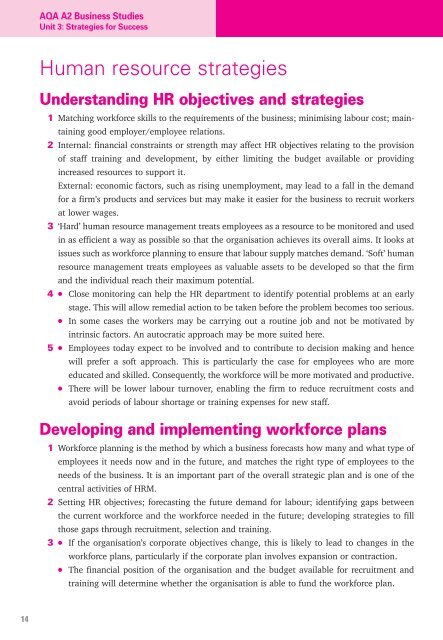A2 Business Studies Unit 3 Strategies for Success AQA
A2 Business Studies Unit 3 Strategies for Success AQA
A2 Business Studies Unit 3 Strategies for Success AQA
- No tags were found...
Create successful ePaper yourself
Turn your PDF publications into a flip-book with our unique Google optimized e-Paper software.
<strong>AQA</strong> <strong>A2</strong> <strong>Business</strong> <strong>Studies</strong><strong>Unit</strong> 3: <strong>Strategies</strong> <strong>for</strong> <strong>Success</strong>Human resource strategiesUnderstanding HR objectives and strategies1 Matching work<strong>for</strong>ce skills to the requirements of the business; minimising labour cost; maintaininggood employer/employee relations.2 Internal: financial constraints or strength may affect HR objectives relating to the provisionof staff training and development, by either limiting the budget available or providingincreased resources to support it.External: economic factors, such as rising unemployment, may lead to a fall in the demand<strong>for</strong> a firm’s products and services but may make it easier <strong>for</strong> the business to recruit workersat lower wages.3 ‘Hard’ human resource management treats employees as a resource to be monitored and usedin as efficient a way as possible so that the organisation achieves its overall aims. It looks atissues such as work<strong>for</strong>ce planning to ensure that labour supply matches demand. ‘Soft’ humanresource management treats employees as valuable assets to be developed so that the firmand the individual reach their maximum potential.4 ● Close monitoring can help the HR department to identify potential problems at an earlystage. This will allow remedial action to be taken be<strong>for</strong>e the problem becomes too serious.● In some cases the workers may be carrying out a routine job and not be motivated byintrinsic factors. An autocratic approach may be more suited here.5 ● Employees today expect to be involved and to contribute to decision making and hencewill prefer a soft approach. This is particularly the case <strong>for</strong> employees who are moreeducated and skilled. Consequently, the work<strong>for</strong>ce will be more motivated and productive.● There will be lower labour turnover, enabling the firm to reduce recruitment costs andavoid periods of labour shortage or training expenses <strong>for</strong> new staff.Developing and implementing work<strong>for</strong>ce plans1 Work<strong>for</strong>ce planning is the method by which a business <strong>for</strong>ecasts how many and what type ofemployees it needs now and in the future, and matches the right type of employees to theneeds of the business. It is an important part of the overall strategic plan and is one of thecentral activities of HRM.2 Setting HR objectives; <strong>for</strong>ecasting the future demand <strong>for</strong> labour; identifying gaps betweenthe current work<strong>for</strong>ce and the work<strong>for</strong>ce needed in the future; developing strategies to fillthose gaps through recruitment, selection and training.3 ● If the organisation’s corporate objectives change, this is likely to lead to changes in thework<strong>for</strong>ce plans, particularly if the corporate plan involves expansion or contraction.● The financial position of the organisation and the budget available <strong>for</strong> recruitment andtraining will determine whether the organisation is able to fund the work<strong>for</strong>ce plan.14
















